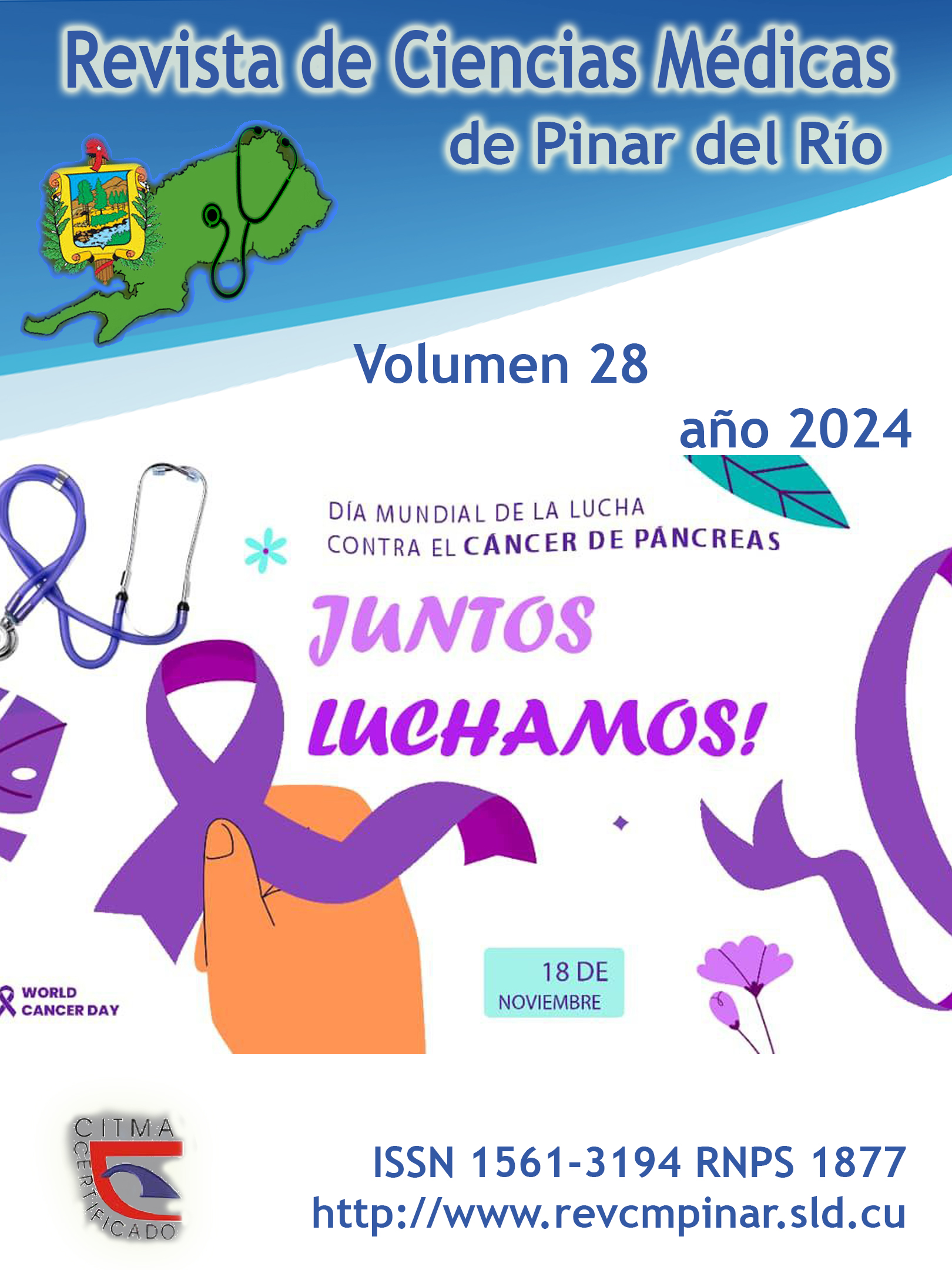Most frequent pediatric age dermatoses in Pinar del Río
Keywords:
SKIN DISEASES, FUR, SKIN CARE, PEDIATRICS, CHILD HEALTH.Abstract
Introduction: pediatric dermatoses constitute a heterogeneous group of skin diseases affecting children and adolescents, and nowadays there is an increase in this age group in dermatology consultations and they require comprehensive medical care.
Objective: to describe the behavior of the most frequent dermatoses in children and adolescents.
Methods: an observational, descriptive and cross-sectional study was carried out in the city of Pinar del Río in 2023. A probabilistic, simple random sample of 811 patients between the ages of zero and 19 years, who presented skin diseases, was used, using individual clinical histories and dermatological physical examination to obtain the information that led to the variables studied. The principles of medical ethics were taken into account.
Results: female sex and age group from five to 10 years old predominated, being skin phototype III the most evident due to dermatological affections. Among them, scabies, acne and cutaneous viruses were the most distinctive, showing a higher representation in individuals with white skin color. Regarding associated pathologies, dermatoses are more common in diabetic patients.
Conclusions: Early detection of skin diseases in children, with greater emphasis on those with related risk factors, will allow rapid intervention in their treatment. This will help to reduce the risk of complications and lasting effects, while improving the quality of life of these patients.
Downloads
References
1. Gonzáles-Lastres T, Gárces-García AE, Casado-Méndez PR, Salvador Santos-Fonseca R, del Castillo-Remón IL, Jiménez-Almaguer D. Prevalencia de enfermedades dermatológicas en escolares del Consejo Popular Pesquera. Archivo Médico de Camagüey [Internet]. 2019 [citado 11/12/2023]; 23(1): [aprox. 5 p.]. Disponible en:
http://scielo.sld.cu/scielo.php?script=sci_arttext&pid=S1025-02552019000100019
2. Tempark T, Whaidee K, Bongsebandhu-Phubhakdi C, Suteerojntrakool O. Prevalence of skin diseases in school-age children. Fam Pract [Internet]. 2022 [citado 12/01/2024]; 39(3): 340-345. Disponible en: https://pubmed.ncbi.nlm.nih.gov/34871400/
3. Folgar Contreras MJ, Ramos Rodríguez MM, Pastrana González KS. Prevalencia de dermatitis atópica en niños y adolescentes en zonas rurales / urbanas de Honduras. Rev Cient Med. [Internet]. 2019 (citado 12/02/2024); 22(2). Disponible en:
http://www.scielo.org.bo/scielo.php?script=sci_arttext&pid=S1817-74332019000200004
4. Organización Mundial de la Salud.(WHO) Sarna[Internet]; 31 de mayo 2023 (citado 12/02/2024). Disponible en: https://www.who.int/es/news-room/fact-sheets/detail/scabies
5. Saldaña Aldana M, Fajardo cabrales Y, Polanco Zamora AL, Ponce Suros Y, Gonzales Lovet N. Aspectos epidemiológicos de la escabiosis infantil en el servicio de miscelánea. Hospital pediátrico docente Bayamo. Multimed [Internet]. 2020 [citado 11/12/2023]; 24 (1): [aprox. 5 p.]. Disponible en:
http://scielo.sld.cu/scielo.php?script=sci_arttext&pid=S1028-48182020000100007
6. Kacar SD, Ozuguz P, Polat S, Manav V, Bukulmez A, Karaca S. Epidemiología de dermatosis pediátricas en la región centro-occidental de Anatolia en Turquía. Arch Argent Pediatr [Internet]. 2014 [citado 12/01/2024]; 112(5): [aprox. 5 p.]. Disponible en:
https://www.sap.org.ar/docs/publicaciones/archivosarg/2014/v112n5a06.pdf
7. Sánchez Bernal J, Monte Serrano J, Aldea Manrique B, Zárate Tejero I. Escabiosis en lactante: diagnóstico dermatoscópico y test de Müller. Rev Pediatr Aten Primaria [Internet]. 2021 [citado 16/01/2024]; 23(89): [aprox. 5 p.]. Disponible en:https://scielo.isciii.es/scielo.php?script=sci_arttext&pid=S1139-76322021000100013
8. Vega-Morquecho OA. Las dermatosis infantiles en las tesis de la Escuela Nacional de Medicina, 1902-1960. Dermatología CMQ [Internet]. 2022 [citado 16/01/2024]; 20(3): 328-333. Disponible en:
https://www.medigraphic.com/pdfs/cosmetica/dcm-2022/dcm223m.pdf
9. -Muñoz L, Belmar Madrid C, Conde-Taboada A, Iglesias Puzas A, Gonzalez Guerra E, López-Bran E. Quality of life in children with skin disease: A Spanish Sample. Anales de pediatria [Internet]. 2023 [citado 12/01/2024]; 99:170-175. Disponible en:
https://www.analesdepediatria.org/en-quality-life-in-children-with-articulo-S2341287923001898
10. Kim G, Caprio S. Diabetes and insulin resistance in pediatric obesity. Pediatr Clin North Am[Internet]. 2011 [citado 12/01/2024]; 58(6): 1355-1361. Disponible en: http://dx.doi.org/10.1016/j.pcl.2011.09.002
Downloads
Published
How to Cite
Issue
Section
License
Authors who have publications with this journal agree to the following terms: Authors will retain their copyrights and grant the journal the right of first publication of their work, which will be publication of their work, which will be simultaneously subject to the Creative Commons Attribution License (CC-BY-NC 4.0) that allows third parties to share the work as long as its author and first publication in this journal are indicated.
Authors may adopt other non-exclusive license agreements for distribution of the published version of the work (e.g.: deposit it in an institutional telematic archive or publish it in a volume). Likewise, and according to the recommendations of the Medical Sciences Editorial (ECIMED), authors must declare in each article their contribution according to the CRediT taxonomy (contributor roles). This taxonomy includes 14 roles, which can be used to represent the tasks typically performed by contributors in scientific academic production. It should be consulted in monograph) whenever initial publication in this journal is indicated. Authors are allowed and encouraged to disseminate their work through the Internet (e.g., in institutional telematic archives or on their web page) before and during the submission process, which may produce interesting exchanges and increase citations of the published work. (See The effect of open access). https://casrai.org/credit/



